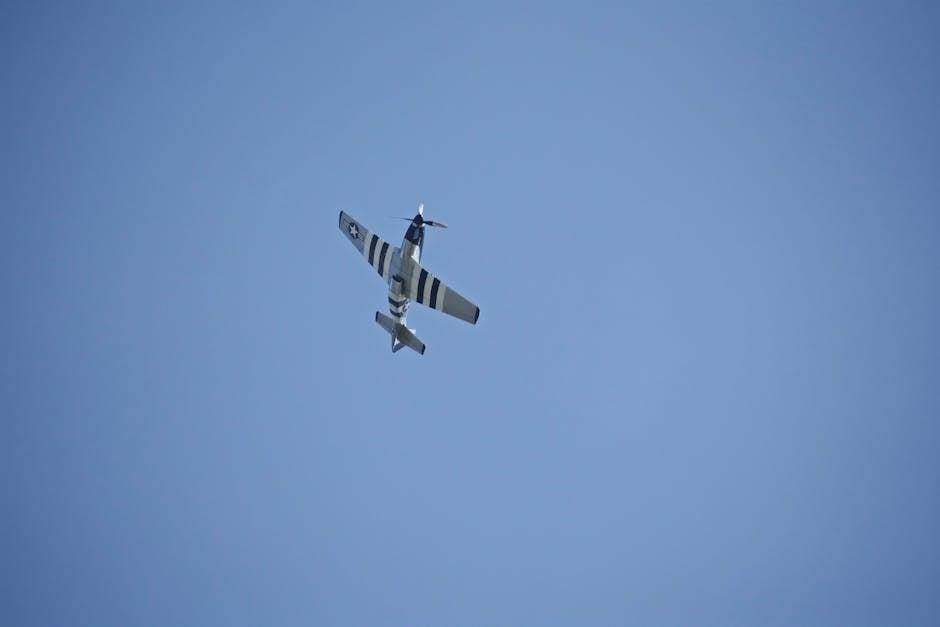
The WWII Aircraft Glossary is a comprehensive guide detailing terms related to aircraft from World War II, covering fighters, bombers, naval aircraft, and more. It includes abbreviations and historical context, providing a detailed understanding of aviation terminology from the era.
1.1 Overview of the Glossary
The WWII Aircraft Glossary serves as a vital reference for understanding terminology related to World War II aviation. It covers a wide range of topics, including fighter, bomber, and naval aircraft, as well as key abbreviations and historical context. Designed for both newcomers and experts, the glossary provides detailed descriptions of aircraft types, their roles, and technical specifications. Available as a free PDF download, it offers a comprehensive resource for anyone interested in WWII aviation history, ensuring clarity and depth in understanding the era’s aerial warfare.
1.2 Importance of Understanding WWII Aircraft Terminology
Understanding WWII aircraft terminology is crucial for grasping the historical significance and technical aspects of aviation during the war. It provides insight into the roles of different aircraft, such as fighters, bombers, and naval planes, and their impact on military strategies. Familiarity with terms like “Liberator,” “Spitfire,” and “Zero” enhances understanding of key battles and technological advancements; This knowledge aids researchers, historians, and enthusiasts in analyzing the era’s aerial warfare and its lasting influence on aviation.
1.3 Sources for the Glossary
The WWII Aircraft Glossary draws from diverse sources, including military archives, historical publications, and expert research. Key resources include The Illustrated Encyclopedia of Combat Aircraft of World War II, Air War Publications, and official military manuals. These sources provide detailed descriptions of aircraft, terminology, and historical context. Additionally, online archives and forums dedicated to WWII aviation offer valuable insights. These materials ensure the glossary is accurate, comprehensive, and accessible for researchers and enthusiasts alike.
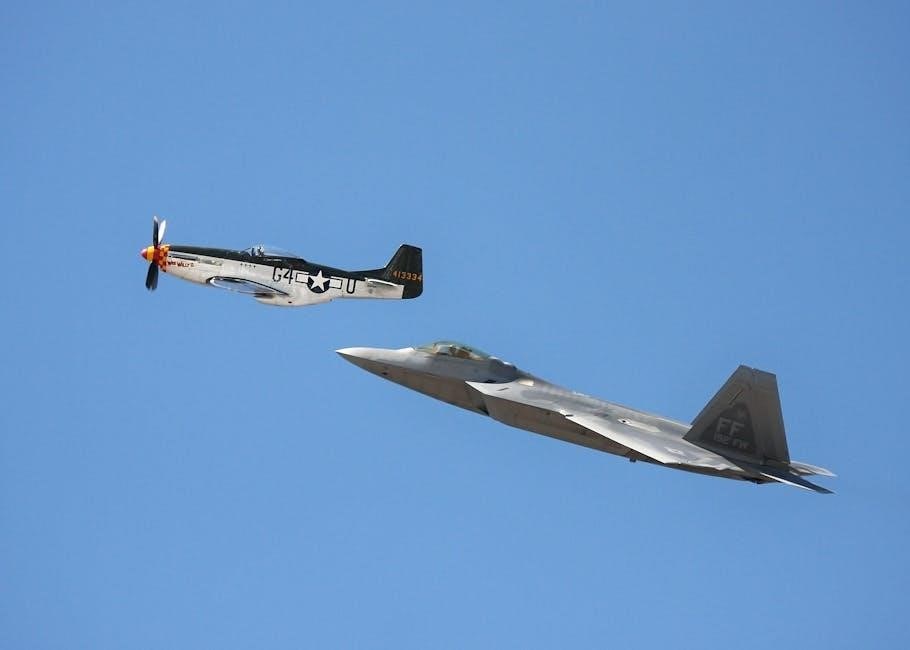
Key Definitions of WWII Aircraft Terminology
This section provides essential definitions for WWII aircraft terminology, covering fighters, bombers, naval aircraft, and ground support planes, as well as key systems and historical context.
2.1 Fighter Aircraft
Fighter aircraft were crucial during WWII, designed for air-to-air combat, protecting bombers, and dominating skies. They featured high speed, maneuverability, and armament like machine guns or cannons. Notable examples include the Supermarine Spitfire, North American P-51 Mustang, and Mitsubishi A6M Zero. These planes played pivotal roles in key battles, utilizing radar and advanced tactics. Their evolution reflected technological advancements, with designs optimizing performance for dogfighting or interception, making them iconic symbols of WWII aviation and strategic importance.
2.2 Bomber Aircraft
Bomber aircraft were pivotal in WWII, designed to carry and drop bombs on enemy targets. They varied in size, range, and payload capacity, with notable examples like the B-17 Flying Fortress and B-24 Liberator. Bombers played a crucial role in strategic missions, targeting industrial and military sites. They often featured heavy armament for defense and advanced navigation systems. The B-29 Superfortress, with its pressurized cabins and long range, exemplified technological advancements. Bombers were central to weakening enemy infrastructure and morale, making them a key component of WWII aviation strategy.
2.3 Naval Aviation Terminology
Naval aviation terminology refers to aircraft designed for maritime operations, including carrier-based planes and seaplanes. These aircraft often featured retractable floats or amphibious capabilities, enabling operation from both land and water. Key WWII examples include the TBF Avenger and Aichi D3A. Naval aircraft played a critical role in reconnaissance, anti-submarine warfare, and fleet support. Their designs emphasized durability, versatility, and adaptability to harsh maritime environments, making them indispensable in naval battles and strategic operations during the war.
2.4 Ground Support Aircraft
Ground support aircraft played a vital role in WWII, providing logistical and tactical assistance. These included transport planes like the C-47 Skytrain, which ferried troops and supplies, and gliders used for airborne operations. Liaison aircraft, such as the L-4 Grasshopper, enabled communication between ground units. These planes were essential for maintaining supply lines, conducting reconnaissance, and supporting infantry operations, proving indispensable in both strategic and tactical contexts throughout the war.
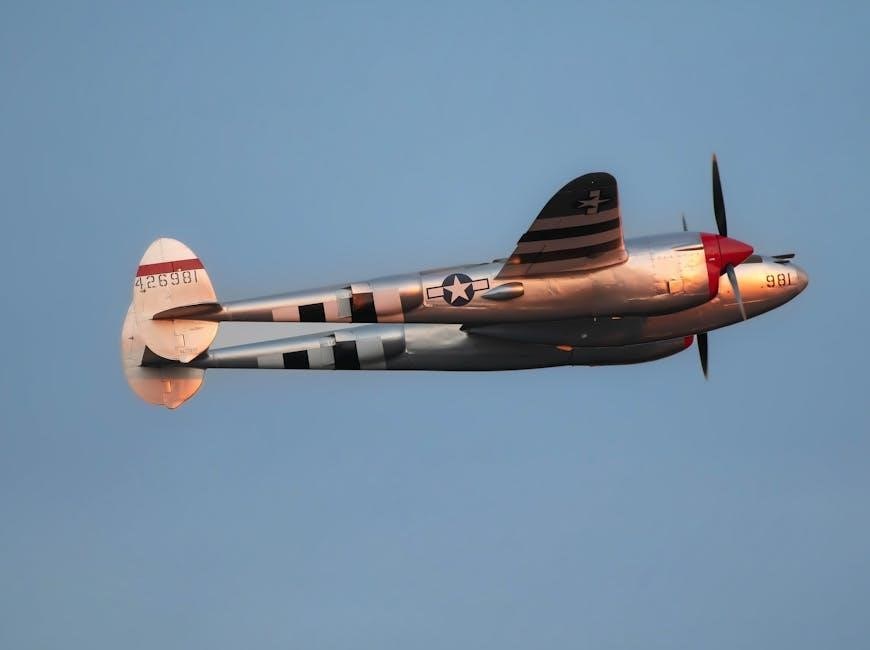
Major Aircraft Types of WWII
Major WWII aircraft types include fighters, bombers, and ground support planes, each serving distinct roles. Fighters like Spitfires and Mustangs excelled in air combat, while bombers such as B-17s delivered payloads. Naval and transport aircraft also played crucial roles, highlighting the diversity and complexity of aviation during the war.
3.1 Allied Aircraft
The Allied forces utilized a diverse range of aircraft during WWII, including iconic fighters like the Supermarine Spitfire and P-51 Mustang, and bombers such as the B-17 Flying Fortress and B-24 Liberator. Soviet aircraft, like the IL-2 Sturmovik, played significant roles in ground support. British bombers, such as the Avro Lancaster, conducted nighttime raids, while American aircraft dominated daylight operations. These planes were instrumental in securing Allied victories, showcasing advanced engineering and strategic versatility that shaped the war’s outcome.
3.2 Axis Aircraft
Axis powers, including Germany, Japan, and Italy, developed a range of aircraft that played critical roles in WWII. German planes like the Messerschmitt Bf 109 and Focke-Wulf Fw 190 dominated air combat, while the Junkers Ju 87 Stuka excelled in ground attacks. Japan’s Mitsubishi A6M Zero was renowned for its agility, and the Kawasaki Ki-45 Toryu served as a versatile night fighter. Italian aircraft, such as the Macchi C.200, also contributed to Axis operations. These planes were integral to Axis strategies, showcasing advanced engineering and tactical adaptability during the war.
3.3 Experimental and Prototype Aircraft
During WWII, experimental and prototype aircraft pushed the boundaries of aviation technology. Germany developed the Horten Ho 229, a jet-powered flying wing with stealth capabilities, while the Messerschmitt Me 262 was the first operational jet fighter. Japan experimented with the Mitsubishi J8M Shusui, a rocket-powered interceptor. These innovative designs, though often not widely produced, showcased cutting-edge engineering. They laid the groundwork for post-war advancements in aviation, despite many never entering full combat service.
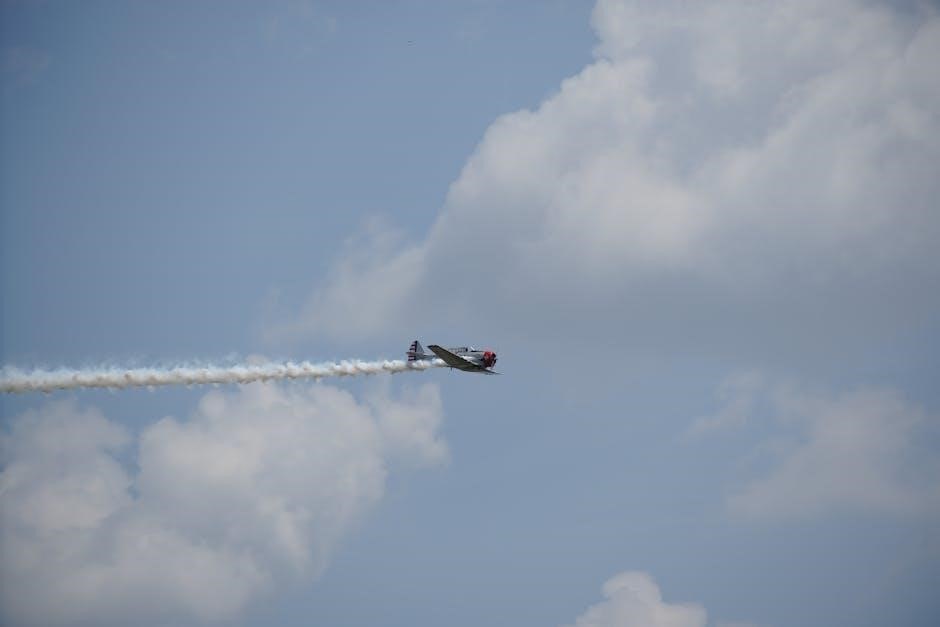
Allied Aircraft Details
Allied forces utilized iconic aircraft like the P-51 Mustang, Supermarine Spitfire, and B-17 Flying Fortress. These planes played pivotal roles in air superiority, bombing missions, and ground support.
4.1 American Aircraft
American WWII aircraft included iconic planes like the P-51 Mustang, B-17 Flying Fortress, and B-29 Superfortress. These aircraft played crucial roles in air superiority, strategic bombing, and long-range missions. The P-51 Mustang, with its exceptional range, escorted bombers deep into enemy territory. The B-17 Flying Fortress was a durable bomber known for its defensive capabilities, while the B-29 Superfortress introduced advanced technology, including a pressurized cabin and remote-controlled gun turrets. These innovations set the stage for modern aviation advancements.
4.2 British Aircraft
British WWII aircraft were instrumental in air defense and offensive operations. The Supermarine Spitfire and Hawker Hurricane were pivotal in the Battle of Britain, providing air superiority. The Spitfire, known for its agility, became a symbol of British resistance. The Avro Lancaster, a heavy bomber, conducted nighttime raids, delivering significant payloads. These aircraft, along with others like the de Havilland Mosquito, showcased British engineering and played a crucial role in Allied victories, contributing to the war’s outcome with their versatility and strategic impact.
4.3 Soviet Aircraft
The Soviet Union produced notable aircraft during WWII, with the IL-2 Sturmovik being one of the most significant. As a ground-attack aircraft, it played a crucial role in supporting infantry. The Yak-3 and La-5/7 series were highly maneuverable fighters, excelling in dogfights. These aircraft were vital on the Eastern Front, contributing to key battles like Stalingrad and Kursk. Their durability and adaptability made them essential to Soviet airpower, ensuring significant impact on the war’s outcome.
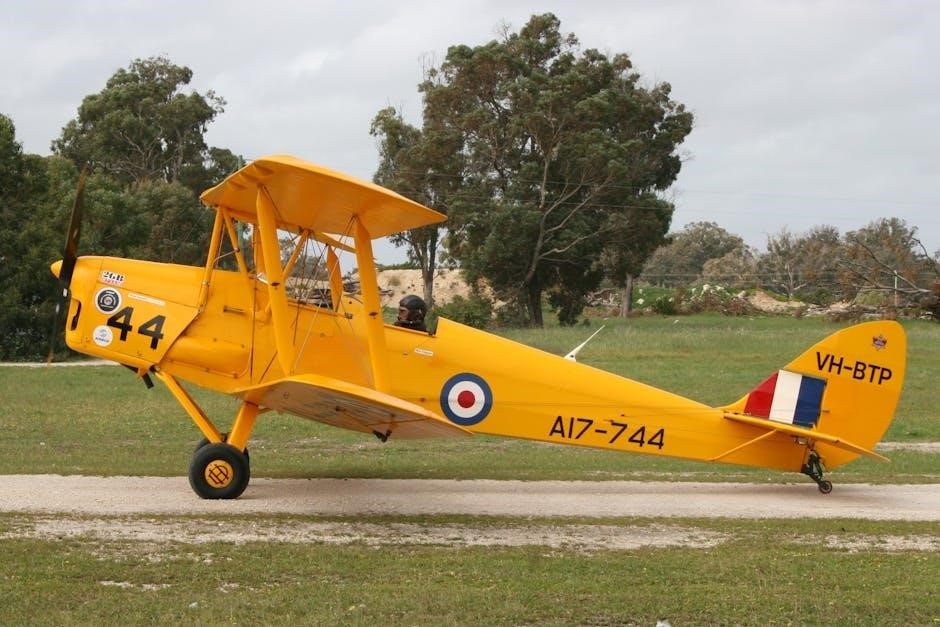
Axis Aircraft Details
Axis aircraft, including German, Japanese, and Italian planes, played pivotal roles in WWII. Notable models like the Messerschmitt Bf 109, Mitsubishi A6M Zero, and Macchi C.202 showcased advanced designs and strategic importance.
5.1 German Aircraft
German WWII aircraft, such as the Messerschmitt Bf 109 and Junkers Ju 87 Stuka, were renowned for their engineering and combat effectiveness. The Bf 109, a versatile fighter, dominated skies, while the Stuka excelled in ground attacks. The Messerschmitt Bf 110, a heavy fighter, and the Focke-Wulf Fw 190, with its superior maneuverability, played crucial roles. These aircraft showcased Germany’s technological prowess and significantly influenced WWII air combat strategies, leaving a lasting legacy in aviation history.
5.2 Japanese Aircraft
Japanese WWII aircraft, such as the Mitsubishi A6M Zero, were known for their agility and range, dominating early war skies. The Nakajima B5N “Kate” torpedo bomber played a key role in battles like Pearl Harbor. Other notable planes include the Yokosuka D4Y “Judy,” used for reconnaissance and dive bombing, and the Kawasaki Ki-45 “Nick,” a twin-engine fighter. These aircraft significantly influenced Japanese naval and air strategies, showcasing their engineering and tactical adaptability during the conflict.
5.3 Italian Aircraft
Italian WWII aircraft, such as the Macchi C.200 and C.202, were renowned for their aerodynamic design and agility. The C.202, an improved version of the C.200, featured a more powerful engine, making it a formidable interceptor. The Savoia-Marchetti SM.79 was a key bomber, known for its speed and torpedo-carrying capability. Additionally, the Fiat BR.20 was a twin-engine bomber used for strategic missions. These aircraft played significant roles in Italian operations, particularly in the Mediterranean theater, showcasing their engineering and operational versatility during the war.
Naval Aviation Terminology
Naval aviation terminology includes terms like carrier-based aircraft, seaplanes, and amphibious planes. Key WWII examples include the Mitsubishi A6M Zero and Supermarine Seafire, vital for maritime operations.
6.1 Carrier-Based Aircraft
Carrier-based aircraft were pivotal in WWII naval operations, enabling air superiority and ground attacks from sea. Notable examples include the Mitsubishi A6M Zero, Grumman TBF Avenger, and Supermarine Seafire. These planes featured folding wings for storage and catapult-assisted takeoffs. Their roles ranged from dogfighting to bombing missions, crucial in battles like Midway and the Pacific Theater. The development of these aircraft reflected advancements in naval aviation technology, emphasizing durability and versatility for maritime combat scenarios.
6.2 Seaplanes and Amphibious Aircraft
Seaplanes and amphibious aircraft were crucial during WWII, enabling operations from water and land. Examples include the Mitsubishi A6M Zero and Supermarine Walrus. These aircraft featured pontoons or floats, allowing water landings and takeoffs. They were used for reconnaissance, rescue missions, and anti-submarine patrols. Amphibious planes like the Martin PBM Mariner and Consolidated PBY Catalina played key roles in naval operations, providing versatility for both water and ground-based missions. Their designs reflected the need for adaptability in diverse combat scenarios.
6.3 Naval Aviation Tactics
Naval aviation tactics during WWII emphasized carrier-based operations, with aircraft launched from ships to attack enemy fleets or defend convoys. Escort carriers supported amphibious assaults, while dive-bombers and torpedo planes targeted enemy ships. Anti-submarine patrols were crucial, employing depth charges and radar. Coordinated attacks, such as those during the Battle of Midway, highlighted the importance of strategic planning and rapid deployment. These tactics evolved to counter threats like submarines and kamikaze attacks, showcasing adaptability and innovation in naval air warfare.
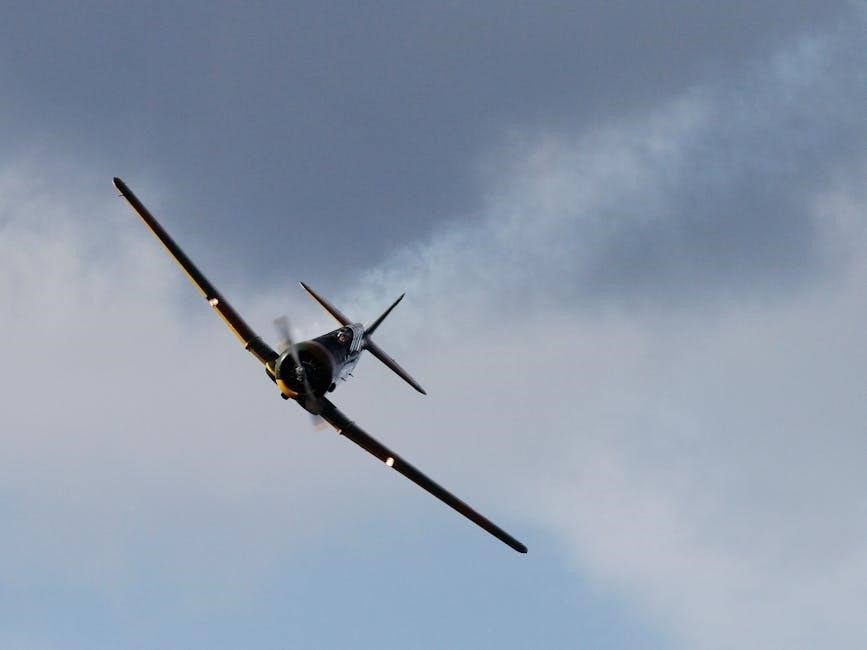
Ground Support and Transport Aircraft
Ground support and transport aircraft played a vital role in WWII, enabling troop transport, supply delivery, and medical evacuations. These planes were essential for logistical operations.
7.1 Transport Aircraft
Transport aircraft during WWII were crucial for moving troops, supplies, and equipment. Planes like the C-47 Skytrain and Ju 52 were widely used, offering reliability and capacity. These aircraft enabled rapid deployment and logistical support, playing a key role in military operations. Their versatility allowed for cargo transport, paratrooper drops, and medical evacuations. Transport aircraft were essential for sustaining forces in remote and combat zones, significantly impacting the war’s outcome with their consistent performance and adaptability.
7.2 Liaison and Observation Aircraft
Liaison and observation aircraft were small, versatile planes used for reconnaissance, artillery spotting, and communication. Models like the L-4 Grasshopper and Fieseler Storch excelled in these roles due to their maneuverability and STOL capabilities. These aircraft operated in close proximity to ground forces, providing critical battlefield intelligence. Their ability to fly low and slow made them invaluable for scouting enemy positions and coordinating troop movements. Liaison aircraft also transported small teams or supplies, proving indispensable in diverse operational scenarios during WWII.
7.3 Gliders and Towing Aircraft
Gliders and towing aircraft played a unique role in WWII, enabling stealthy troop deployments and equipment transport. Engineless gliders, like the Waco CG-4A and DFS 230, were towed by powered aircraft to deliver troops or supplies behind enemy lines. Constructed with lightweight materials, these gliders were crucial for surprise missions, such as during the invasion of Normandy. Towing aircraft, often modified bombers or transports, were essential for launching gliders, though the process was risky and resource-intensive. Gliders were expendable, offering no return capability, but their ability to land in remote areas made them invaluable for specific operations.
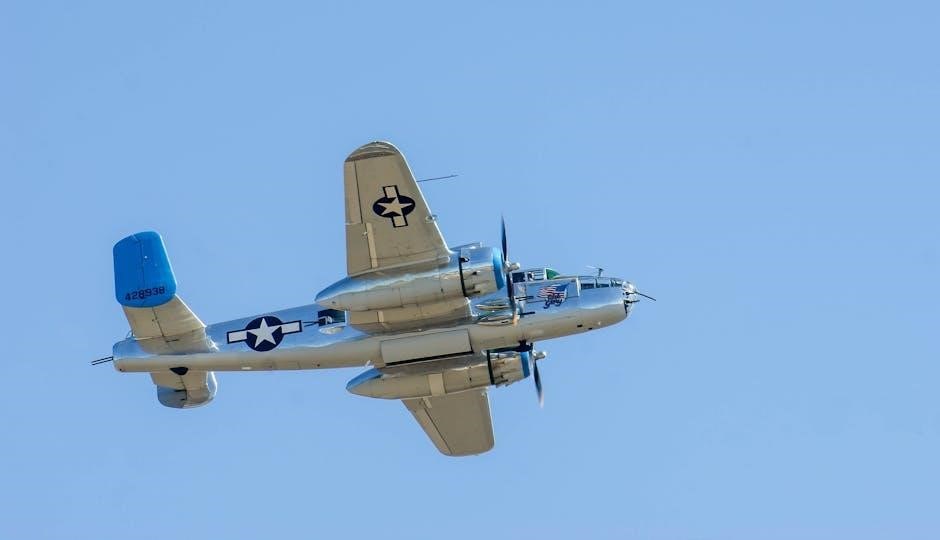
Aircraft Design and Technology
WWII saw significant advancements in aircraft design, including lightweight materials, improved aerodynamics, and enhanced engine power, focusing on speed, maneuverability, and resilience for combat effectiveness.
8.1 Propeller and Engine Technology
During WWII, propeller and engine technology saw significant advancements. Radial engines, like the Pratt & Whitney R-2800, powered iconic fighters, while in-line engines, such as the Rolls-Royce Merlin, were used in planes like the P-51 Mustang. The development of superchargers and turbochargers improved high-altitude performance. Variable-pitch propellers enhanced efficiency, allowing aircraft to optimize speed and climb rates. These innovations were critical in achieving air superiority, with engines like the Daimler-Benz DB 605 powering Axis fighters. The Auxiliary Power Unit (APU) also emerged, supporting aircraft systems independently.
8.2 Radar and Avionics
Radar and avionics played a pivotal role in WWII aviation, revolutionizing air combat and navigation. Early radar systems, like Britain’s Chain Home, detected incoming enemy aircraft, enabling early warnings. German systems, such as Freya and Würzburg, aided in similar capacities. Avionics advancements included radio navigation aids like Gee-H and fire control systems, enhancing accuracy. Radar-equipped night fighters, such as the Bristol Beaufighter, became highly effective. These technologies significantly influenced air superiority and tactical operations, marking the dawn of modern electronic warfare in aviation.
8.3 Armor and Defensive Systems
Armor and defensive systems in WWII aircraft were critical for survival. Armor plating protected vital areas like cockpits and engines, while self-sealing fuel tanks reduced fire risks. Defensive armaments included machine guns, cannons, and turrets. Some aircraft, like bombers, relied on rear gunners for protection. Countermeasures such as chaff and flares were introduced to evade enemy fire. These innovations significantly improved aircraft survivability, enabling them to withstand combat damage and complete missions effectively. Armor and defensive systems became key factors in determining aircraft longevity during the war.
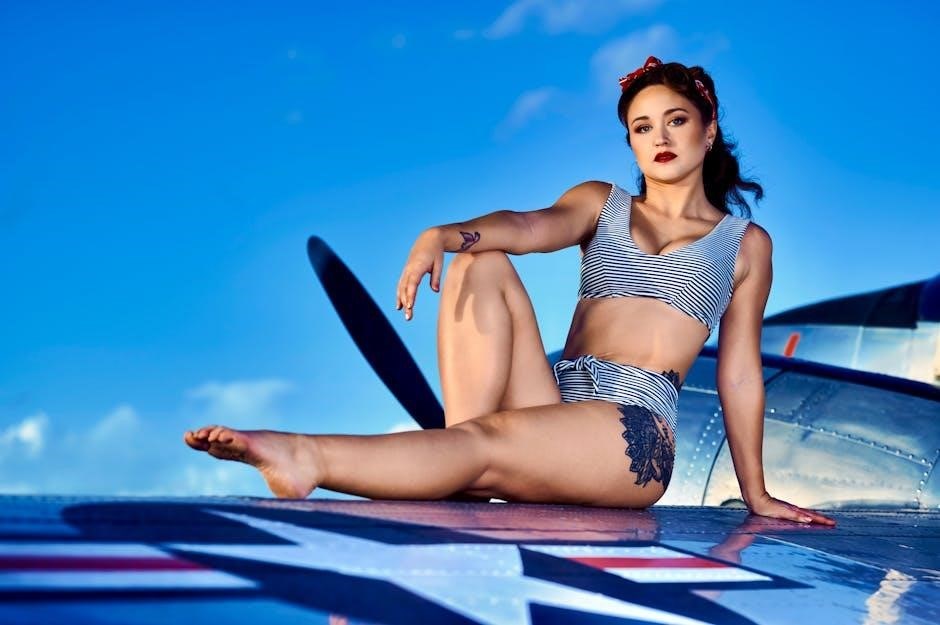
Abbreviations and Acronyms
This section deciphers key WWII aviation abbreviations, such as HP (Horsepower), IAS (Indicated Airspeed), and G-Force, essential for understanding aircraft performance and specifications during the war.
9.1 Common Military Abbreviations
Common military abbreviations during WWII include AA (Antiaircraft), AAF (Army Air Forces), and AAM (Air-to-Air Missile). These terms were crucial for communication and documentation, streamlining operations. ABDA referred to the American/British/Dutch/Australian Command, while HP denoted horsepower in aircraft engines. Understanding these abbreviations is essential for interpreting historical records and technical manuals from the era, providing clarity on military strategies, aircraft specifications, and operational procedures during World War II.
9.2 Aircraft Designation Systems
Aircraft designation systems in WWII used specific codes to identify roles and manufacturers. The US system, for example, employed letter prefixes like B for bombers (e.g., B-17) and P for pursuit/fighter aircraft (e.g., P-51). Germany used designations like Bf for Messerschmitt (e.g., Bf 109) and He for Heinkel. These systems helped classify aircraft by function and origin, aiding military logistics and communication. Understanding these codes is essential for identifying aircraft types and their historical roles during the war.
9.3 Radio and Communication Codes
Radio and communication codes were critical for WWII aircraft operations, ensuring secure and efficient messaging. Codes like “Mayday” signaled distress, while “Scramble” ordered immediate takeoff. The US military used systems like the “Airborne Radio Equipment Handbook” to standardize communication protocols. German forces employed encrypted codes, and the Allies used systems like “Priority” to urgent messages. These codes were vital for coordinating missions, ensuring clarity, and maintaining tactical advantage. Understanding these codes provides insight into WWII aviation communication strategies and their role in military success.
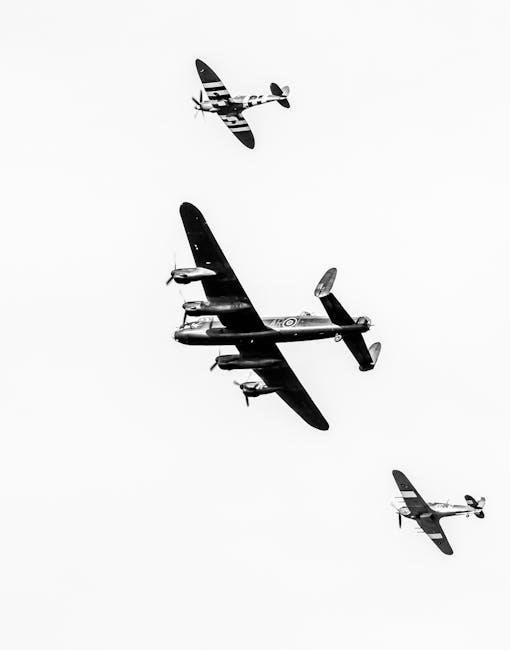
Historical Context of WWII Aviation
WWII aviation played a pivotal role in shaping the war’s outcome, with aircraft evolving from limited use in WWI to becoming central to military strategy and tactics.
10.1 The Role of Aircraft in WWII
Aircraft played a transformative role in WWII, revolutionizing warfare by enabling air superiority, strategic bombing, and naval dominance. Fighters like the Spitfire and P-51 ensured control of the skies, while bombers such as the B-29 conducted long-range missions, altering the nature of warfare. Naval aircraft, including the Zero and Avenger, were pivotal in sea battles, showcasing adapting strategies across theaters. The war accelerated aviation technology, leading to innovations that shaped post-war airpower, making aircraft indispensable to modern military tactics and global conflict dynamics.
10.2 Key Battles Involving Aircraft
Key battles in WWII showcased the pivotal role of aircraft, such as the Battle of Britain, where Spitfires and Hurricanes defended against Luftwaffe, and the Battle of Midway, where carrier-based aircraft decided the Pacific War’s fate. The Battle of Stalingrad saw extensive use of ground-attack planes, while the Marianas Turkey Shoot highlighted U.S. air superiority. These battles demonstrated how aircraft could turn the tide, with strategic bombing and air-to-air combat becoming central to warfare, influencing the ultimate Allied victory and shaping military aviation’s future.
10.3 Evolution of Aircraft Design During the War
WWII drove rapid advancements in aircraft design, with innovations like jet engines, radar, and improved materials. Early warplanes evolved from biplanes to monoplane designs, enhancing speed and maneuverability. The introduction of radar and avionics revolutionized combat tactics, while the development of heavy bombers and transport aircraft supported large-scale operations. Experimental designs, such as the Messerschmitt Me 262 jet fighter, emerged, showcasing the technological race. These advancements laid the foundation for modern aviation, emphasizing speed, durability, and adaptability in aircraft construction.
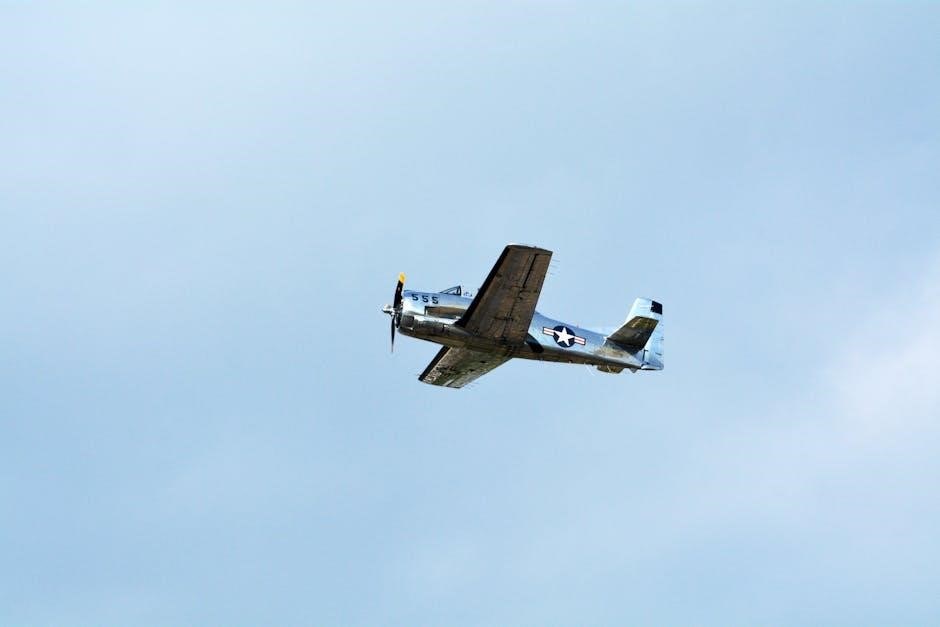
Legacy of WWII Aircraft
WWII aircraft profoundly influenced post-war aviation, with innovations like jet engines and radar becoming standard. Iconic planes like the Spitfire and B-29 symbolize the era’s engineering prowess, inspiring modern enthusiasts and collectors.
11.1 Influence on Post-War Aviation
WWII aircraft innovations like jet engines, radar, and advanced materials revolutionized post-war aviation. The B-29 bomber influenced commercial airliners, while the Gloster Meteor pioneered jet fighters. Helicopters and transport planes became essential for civilian and military use. The war’s technological advancements laid the groundwork for modern aviation, inspiring future designs and operational strategies.
11.2 Preservation and Museum Aircraft
Many WWII aircraft are preserved in museums worldwide, serving as historical artifacts and educational tools. Institutions like the National Museum of the U.S. Air Force and the RAF Museum showcase iconic planes such as the Spitfire and B-29. These exhibits often include interactive displays, providing insights into aircraft design, historical context, and their roles in the war. Preservation efforts ensure future generations can study and appreciate these aviation milestones, maintaining their legacy for educational and inspirational purposes.
11.3 Modern Interest in WWII Aircraft
Modern interest in WWII aircraft remains strong, driven by enthusiasts, historians, and educators. Flight simulators, documentaries, and model kits popularize these planes, while airshows and restorations bring them to life. Online communities and glossaries like the WWII Aircraft Glossary PDF provide detailed information, fostering deeper understanding. This enduring fascination reflects a blend of historical reverence, technological admiration, and the enduring legacy of these aircraft in shaping global history and aviation innovation.
Resources for Further Study
Explore detailed books, online archives, and museums for in-depth knowledge of WWII aircraft, offering historical records, technical specifications, and firsthand accounts of aviation history.
12.1 Recommended Books and Publications
For deeper insights, explore “The Illustrated Encyclopedia of Combat Aircraft of World War II” and “Plane Language” by Bartleby. These books offer detailed aircraft histories, technical specs, and terminologies. Additionally, “Fighter Combat: World War Two, Stories and Tactics” by HP52 provides real-life accounts and strategies. The “Air Service Command’s Airborne Radio Equipment Handbook” and “Japanese Cockpit Interiors” are invaluable for understanding specific systems and designs. These resources enrich your knowledge of WWII aviation history and technology.
12.2 Online Archives and Databases
Explore online archives like Air War Publications, offering detailed WWII aviation articles, blogs, and downloadable resources. The Air Force Historical Research Agency provides extensive digital records, while platforms like the National Archives host wartime documents. Websites such as “Air War Publications” offer free glossaries and manuals, including the “Airborne Radio Equipment Handbook” and “Japanese Cockpit Interiors.” These databases are invaluable for researchers, providing primary sources, technical specifications, and historical insights into WWII aircraft and their operations.
12.3 Museums and Historical Societies
Museums like the National Museum of the U.S. Air Force and the Smithsonian National Air and Space Museum offer extensive collections of WWII aircraft and historical documents. These institutions provide access to rare manuals, aircraft blueprints, and educational resources. The Air Force Historical Research Agency at Maxwell Air Force Base also houses a vast archive of WWII aviation materials. Such museums and societies are essential for preserving and showcasing the history of WWII aircraft, offering valuable resources for researchers and enthusiasts alike.
The WWII Aircraft Glossary serves as an invaluable resource for understanding the terminology, technology, and history of aviation during World War II. By providing detailed definitions and historical context, it bridges the gap between enthusiasts and experts, fostering a deeper appreciation for the era’s aircraft. This comprehensive guide ensures that the legacy of WWII aviation is preserved, offering insights into the planes that shaped the war and beyond.